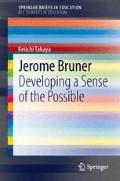Abstract
This chapter examines how we might receive Bruner’s legacy (and Dewey’s before him) and keep its spirit to improve our schools. I will briefly discuss Kieran Egan’s theory of imaginative education and his proposal called “Learning in Depth” (LiD) as an example of how we might improve our schools along the line of Bruner’s thought.
Access this chapter
Tax calculation will be finalised at checkout
Purchases are for personal use only
Notes
- 1.
One of the oldest expressions of this view may be found in Jean-Jacques Rousseau in Émile, when he declared that he intended to write about education of human beings, not that of people becoming lawyers or priests, etc. (p. 41).
- 2.
On the other hand, some educators such as Nel Noddings criticize Bruner for conceiving of what’s essential for human beings only in terms of “academic adequacy”, overlooking the fact that the building of human relations (what she calls “caring relations”) with others is much more essential to everyone (Noddings 1992, p. xii; also, pp. 1, 28, 42, 150, 162).
- 3.
Bruner says, on the one hand, “It never occurred to me to believe in “stages” of development in the Piagetian sense” (Bruner 1983b, p. 154). He, however, converted his “modes of representation” into stages of development; thereby he attempted to overcome the “quietism” of Piaget’s stage theory by using Vygotskian psychology while not discarding Piagetian psychology as a whole (ibid., p. 143).
References
Bruner, J. S. (2007). Cultivating the Possible, Address at Oxford dedication: Jerome Bruner Building. Retrieved on December 28, 2012 from http://www.education.ox.ac.uk/wordpress/wp-content/uploads/2011/03/Transcript-Cultivating-the-Possible.pdf.
Bruner, J. S. (1971). The relevance of education. New York: Norton & Co.
Bruner, J. S. (1983b). In search of mind: Essays in autobiography. New York: Harper and Row.
Bruner, J. S. (1990). Acts of meaning. Cambridge, MA: Harvard University Press.
Dow, P. B. (1991). Schoolhouse politics: Lessons from the Sputnik era. Cambridge, MA: Harvard University Press.
Egan, K. (1997). The educated mind: How cognitive tools shape our understanding. Chicago: University of Chicago Press.
Egan, K. (2005). An imaginative approach to teaching. San Francisco: Jossey-Bass.
Egan, K. (2011). Learning in depth: A simple innovation that can transform schooling. Chicago: University of Chicago Press.
Gardner, H. (2001). Commentary: Jerome Bruner as educator: Personal reflections. In D. Bakhurst & S. G. Shaker (Eds.), Jerome Bruner: Language, culture, self. London: SAGE Publications.
Noddings, N. (1992). The challenge to care in schools: an alternative approach to education. New York: Teachers College Press.
Olson, D. (2007). Jerome Bruner: The cognitive revolution in educational theory. New York: Continuum.
Tyler, R. W. (1949). Basic principles of curriculum and instruction. Chicago and London: The University of Chicago Press.
Warnock, M. (1976). Imagination. Berkeley, CA: University of California Press.
Whitehead, A. N. (1967). The aims of education. New York: The Free Press. (Original work published, 1929).
Author information
Authors and Affiliations
Corresponding author
Rights and permissions
Copyright information
© 2013 The Author(s)
About this chapter
Cite this chapter
Takaya, K. (2013). Improving Our Schools. In: Jerome Bruner. SpringerBriefs in Education(). Springer, Dordrecht. https://doi.org/10.1007/978-94-007-6781-2_5
Download citation
DOI: https://doi.org/10.1007/978-94-007-6781-2_5
Published:
Publisher Name: Springer, Dordrecht
Print ISBN: 978-94-007-6780-5
Online ISBN: 978-94-007-6781-2
eBook Packages: Humanities, Social Sciences and LawEducation (R0)

